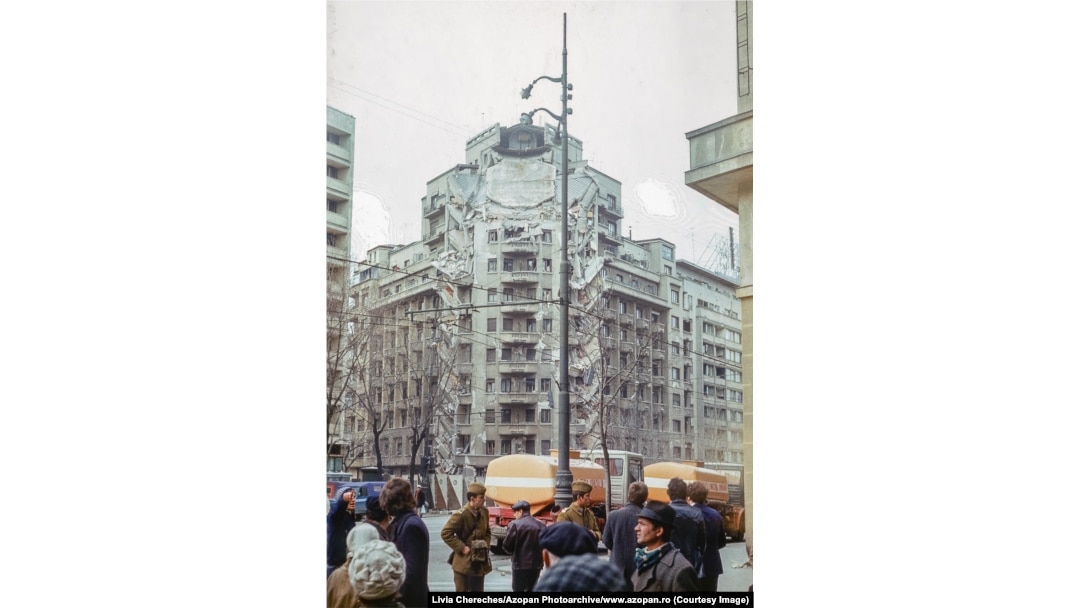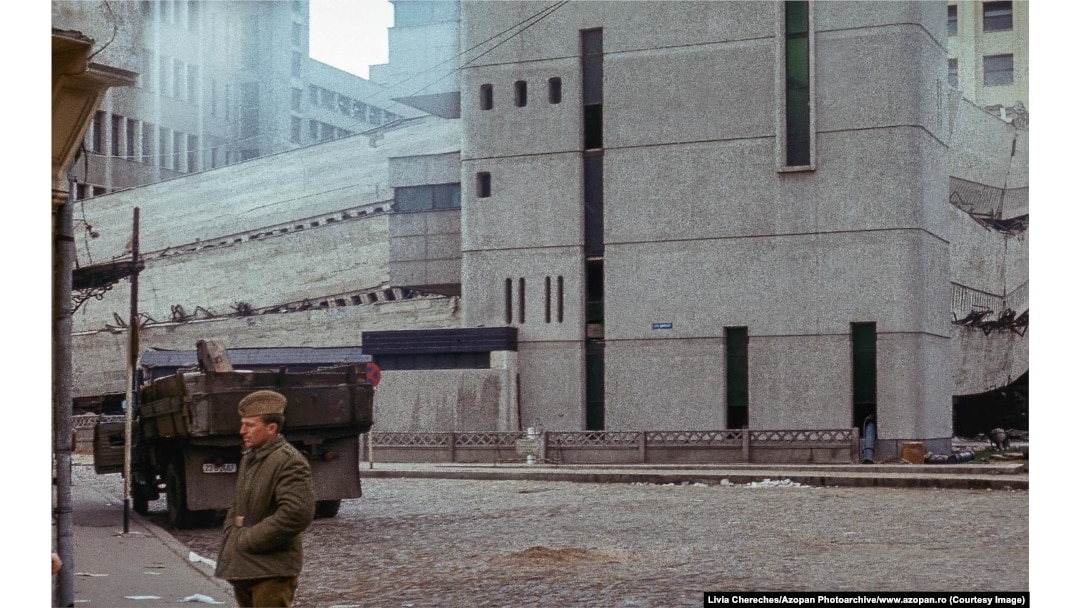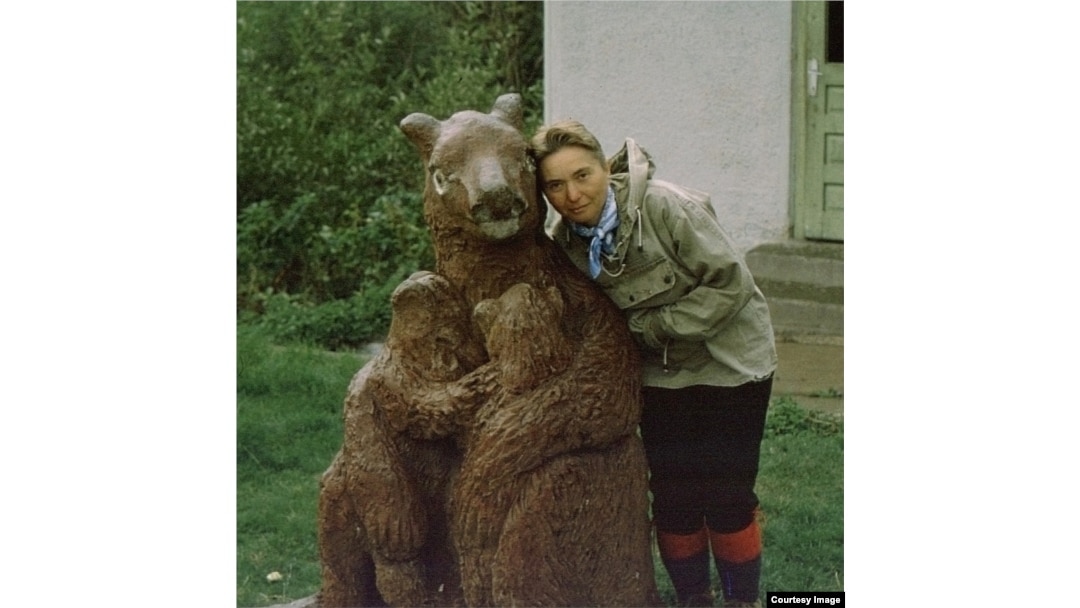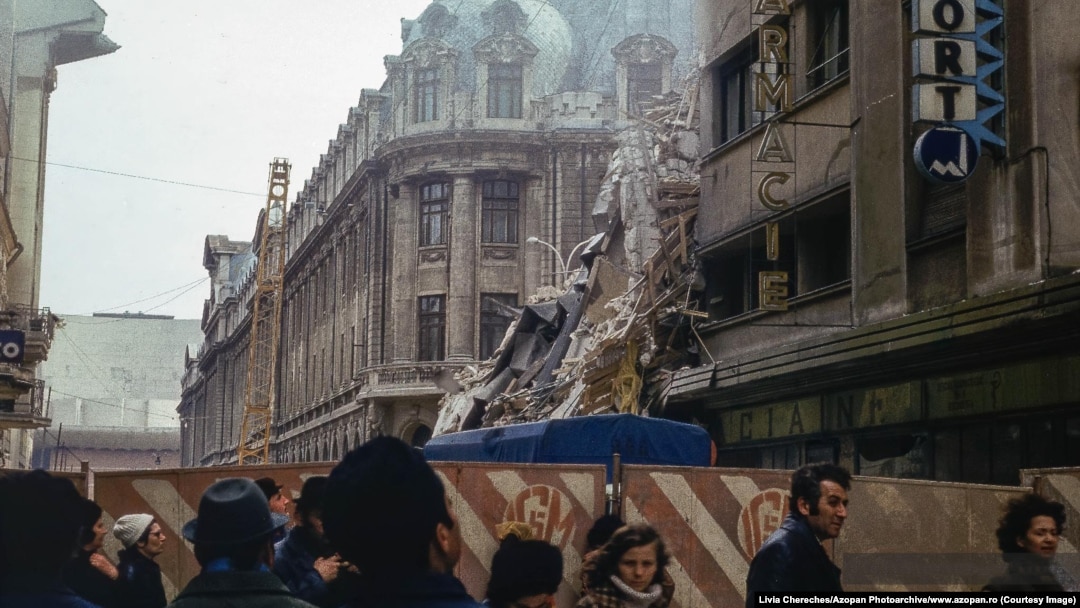In the winter of 1977, Livia Chereches snapped photos of the aftermath of one of modern Europe's worst earthquakes. Then the historic color slides sat in her closet for nearly half a century.

This image, of a badly damaged apartment block in central Bucharest, was taken on March 6, 1977, two days after an earthquake devastated much of Romania.

A Romanian soldier stands near the Ministry of Transport Computer Center in Bucharest.
Tens of thousands of buildings were destroyed and 1,578 were killed in Romania during the 1977 disaster. Additionally, more than 100 people were killed in neighboring Bulgaria.
The quake was centered in a mountainous region north of Bucharest, but the Romanian capital was severely damaged.

Livia Chereches photographed in the 1980s.
Livia Chereches took the photos in this gallery two days after the disaster, then for the next 45 years rarely showed them to anyone. In August 2022, she offered the rare color slides to Azopan, a Romanian photo archive run by volunteers.
Edgar Szocs, one of the founders of Azopan, posted the images to the archive's Facebook page on August 30. He says the images have struck a chord because "the earthquake is still vivid in the memory of the whole Romanian society."
Chereches is now 72, but her recollection of the earthquake and how these photographs were taken remains vivid.
Damage to Ploiesti's Palace of Culture.
Chereches was relaxing in front of the television late on March 4, 1977, when the earthquake hit. At 9:22 p.m., the office worker noticed that "in the corner of the apartment, the wall was parting in two," she told RFE/RL by phone.
With the earthquake under way, Chereches hurried out to her sixth-floor balcony in the western Bucharest suburb of Drumul Taberei to a surreal view.
"There was a strange kind of light, and those big apartment blocks were swaying," she says. For a moment, the young woman expected her life to be over.
Crowds gather near a badly damaged apartment block in central Bucharest.
Chereches then sprang into action, grabbing a rucksack she had packed for a weekend hiking trip and pulling her severely panicked colleague, Adina, out of the apartment.
"The lift was open in front of us, but I didn't let her enter it," Chereches says. "Only because I knew from experience that I was faster than the lift."
A damaged building in Bucharest that was later demolished.
Out on the street, Chereches recalls crowds of people standing around in their nightgowns in the darkness.
"So imagine, there is no light, no electricity, silence," she says. "Everything stopped, and in that moment you are lost. You don’t know if the whole world has disappeared and it’s only you who live, or if this only happened to you, to your area. We didn’t know anything. It was very, very strange."
Through tuning in to Radio Free Europe on a stranger's portable radio, she says, people soon learned that it was an earthquake, that there were deaths, and that most of the damage was in Bucharest.
Workers remove rubble from a destroyed building in central Bucharest.
The immediate urge was to find "someone that you knew, to be near them. You wanted some protection," Chereches says.
As they walked across the city toward Adina's parents' house, the pair neared Bucharest's City Hall, then run by the country's communist regime.
"In the city hall, there was light, perhaps from a generator, and soldiers were coming and going. There was full activity," she remembers. "I wanted to enter to ask for news, but they didn't let me in."
Then, around the next corner, the pair witnessed their first scenes of tragedy.
Crowds gather at the scene of an apartment collapse.
"I saw the worst memory that I have tried to forget. It was an old, high building, burning. It had collapsed totally. Already there were people taking out dead bodies. The smell…was terrible. And there was no organized help still," she says. "It was something made on the spot by ordinary people. I don’t know by who. I only saw they were taking bodies out of the wreckage."
A damaged synagogue that was later demolished.
Incredibly, when the pair made it to Adina's parents' house, the relatives had gone back to sleep. Chereches believes Adina's parents' nonchalant response may have been an example of the survival instinct necessary in communist countries where being noticed by the authorities can upend lives.
"I think [Adina's mother] didn't want to be seen, didn't want to make a fuss. You never knew what behavior is good, what is wrong. It was better just not to be noticed."
Oranges for sale in a shop window. The sign says: "Oranges, very sweet. 13 lei per kilogram."
The following day, Chereches says society was briefly transformed by the tragedy.
"In the street, everyone was very helpful and kind, like I had never seen. People were ready to help, ready to comfort, asking if you needed something."
On the morning after the quake, treats usually reserved for the well-connected were available to all.
"That morning, I remember the shopkeepers opened and put on the shelves hidden things. There were rarities at the time you couldn't get, like oranges, lemons, mineral water. Now everything was displayed. You could buy anything."
The collapsed Ministry of Transport Computer Center.
On March 6, two days after the earthquake, Chereches' boyfriend returned from a trip to the mountains with her camera. It was only then that the amateur photographer could walk around the city to document the aftermath of the disaster, albeit from a distance. By then, authorities had entirely blocked off many streets where the damage was most severe.
When looking back over the photos, Chereches says, "To be honest, I'm a little proud of myself for how calm I was and how I behaved."


